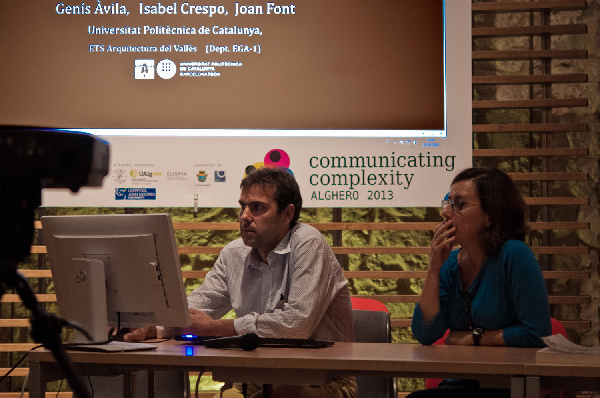Ponència a congrés: 2CO Communicating Complexity 2013 - Animation to explain constructive geometry
Els professors Genís Àvila, Isabel Crespo i Joan Font han presentat la ponència "Animation to explain constructive geometry", dins de la sessió "Informative Animation" del congrés International Design Conference 2CO Communicating Complexity 2013 celebrat els dies 25-26 d'octubre de 2013 a Alghero, Itàlia.
Més informació:
International Design Conference 2CO Communicating Complexity
2CO Communicating Complexity 2013 Conference Proceedings
Àvila, G.; Crespo, I.; Font, J. (2013). Animation to explain constructive geometry. In: 2CO Communicating Complexity 2013 Conference Proceedings, Nuova Cultura - Roma, pp. 214-222, ISBN: 9788868121662.
Abstract
Development and widespread deployment of digital technologies, CAD and CAD-CAM systems, have modified not only the way we work but also the way we think . This fact, which is extensive to all design areas, is even truer in some branches, such as architectural design, sparsely identified with industrial production processes. Having a good CAD system, formalization capabilities are almost limitless. In the planning stage we can conceive all sorts of formal solutions in a relatively easy way. But in most cases this free creativity will clash with the reality of traditional production processes that are still predominant in the field of architectural construction. This contradiction is not important for middle-aged architects, still trained within the framework of a traditional culture, but it is important for young people, and especially for students.
Digital culture is fully integrated into the way new generations think. Today young people are used to generating forms very easily by using a few tools from some CAD software. It is not easy for them, though, to accept that those forms must be rethought from a completely different viewpoint, if they want to build. But this different viewpoint, from the constructive geometry, is rarely found on the Internet, where geometry is usually dealt with from its more mathematical side. We must go to some construction old treatises, where these topics are shown by an anachronistic visual language that is difficult to read for people of the 21st Century. In this context, we believe that animation can be a good resource to show how you can carry out a wide range of constructive forms, only helped by a ruler, a set square and some strings; a range of forms we could see, from current viewpoint, as impossible to be conceived and constructed without any digital system.
Gaudi's work is full of formalizations that from current thinking may seem as inexplicable as the Easter Island statues. However, the fact is that all of them were designed and executed without any of these instruments which seem so essential today. The project we are working on, and the one we want to present to the Conference, aims precisely to show, from a constructive viewpoint and by means of animation, what the geometry that supports the design and construction of several elements of the Gaudi’s work is. In particular, we are planning to present a video clip showing the constructive control of geometry of one of the Palau Güell’s chimneys. Through the visual capability of the animation, this clip goes to show: how the hat of this chimney is governed by a logarithmic spiral and in which way we can control its construction only by means of a ruler, a set square and some strings.
Keywords
Constructive Geometry, Visual Communication, Antoni Gaudí, Architecture.

Comparteix: